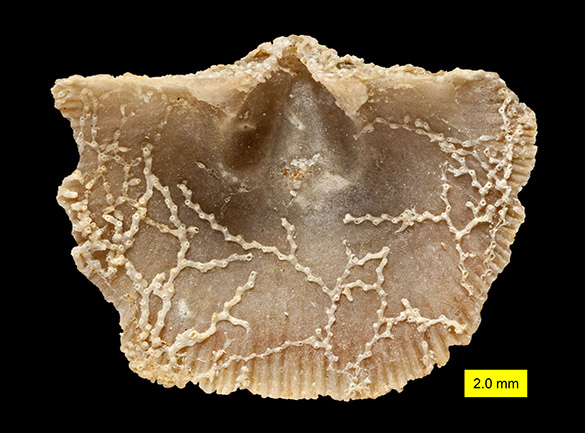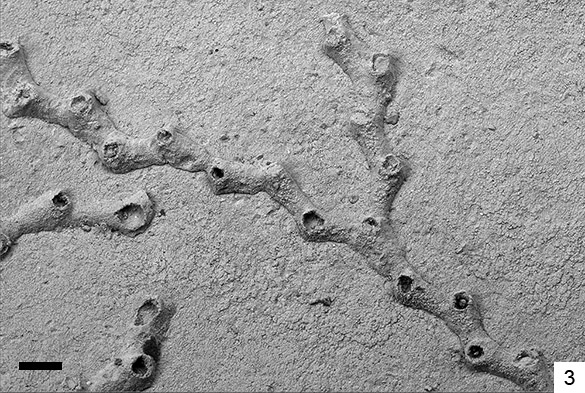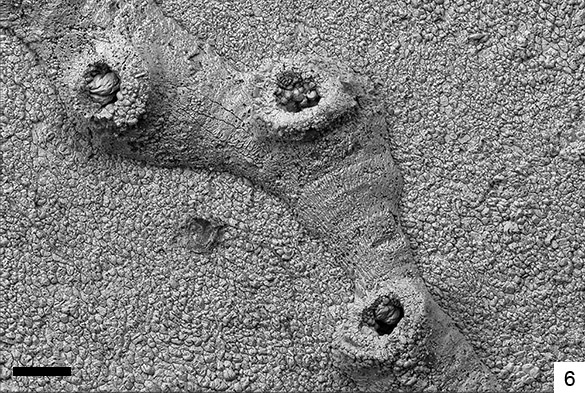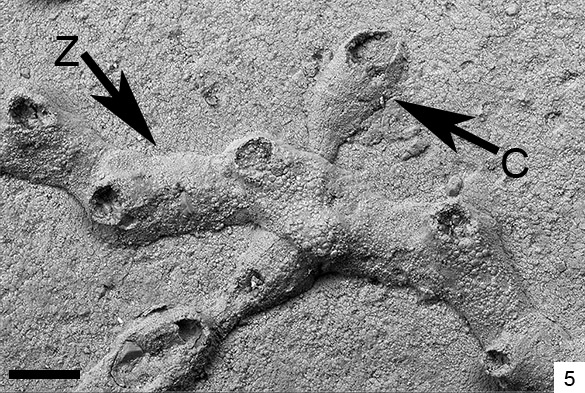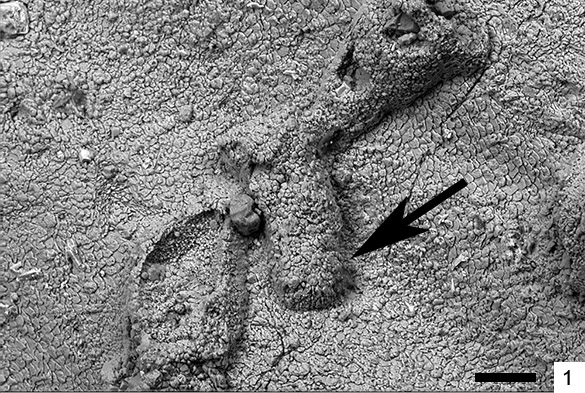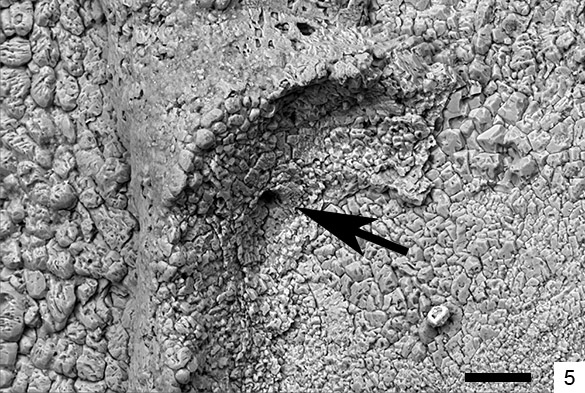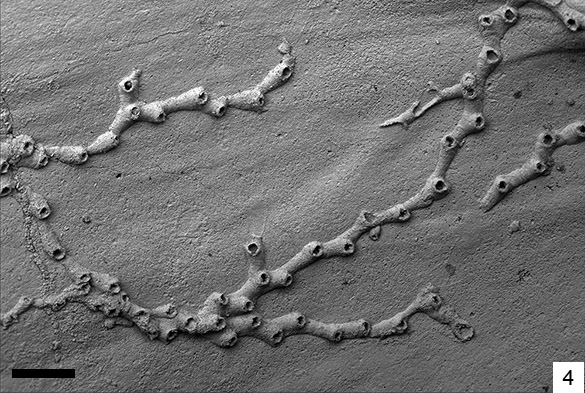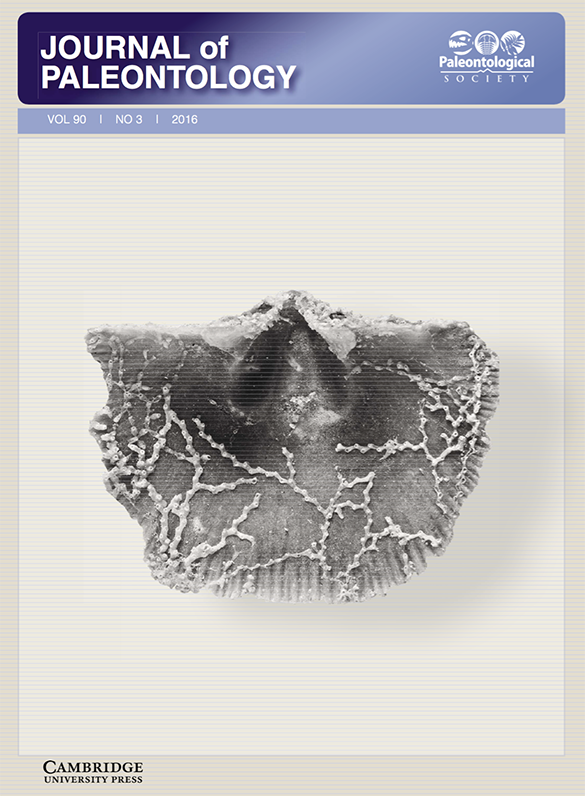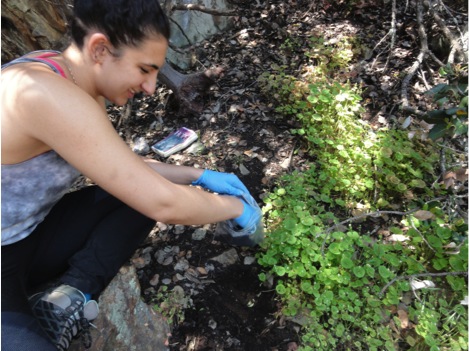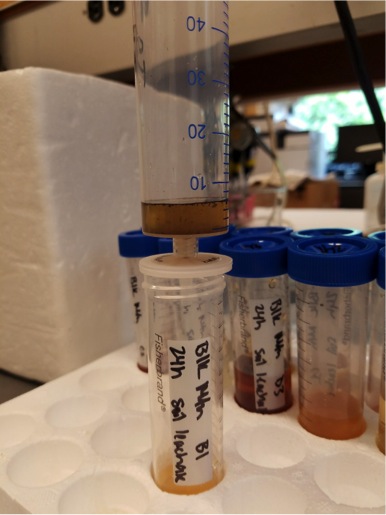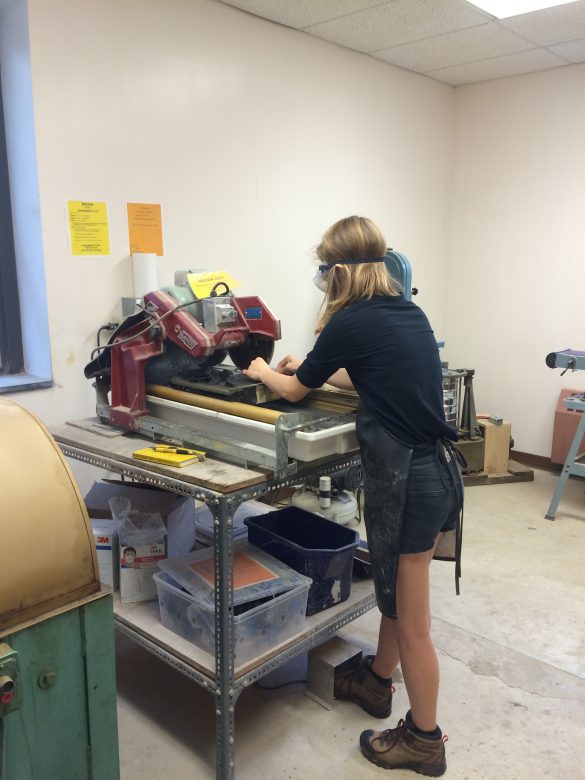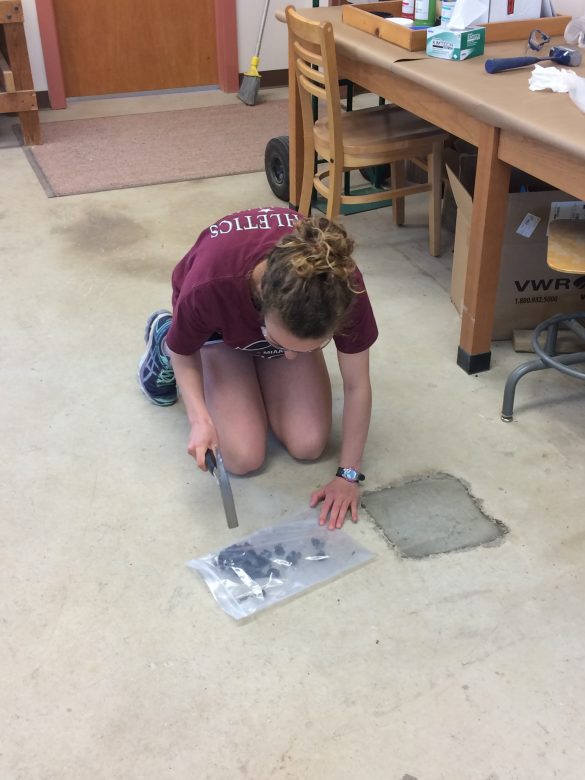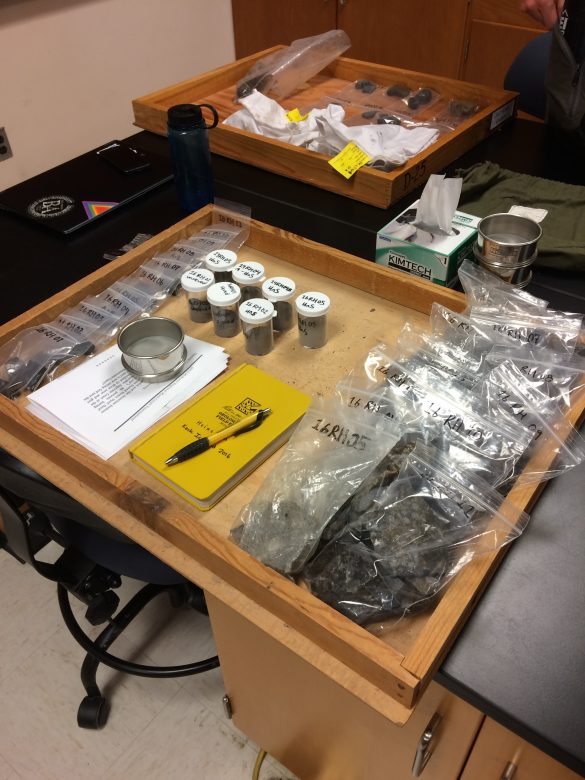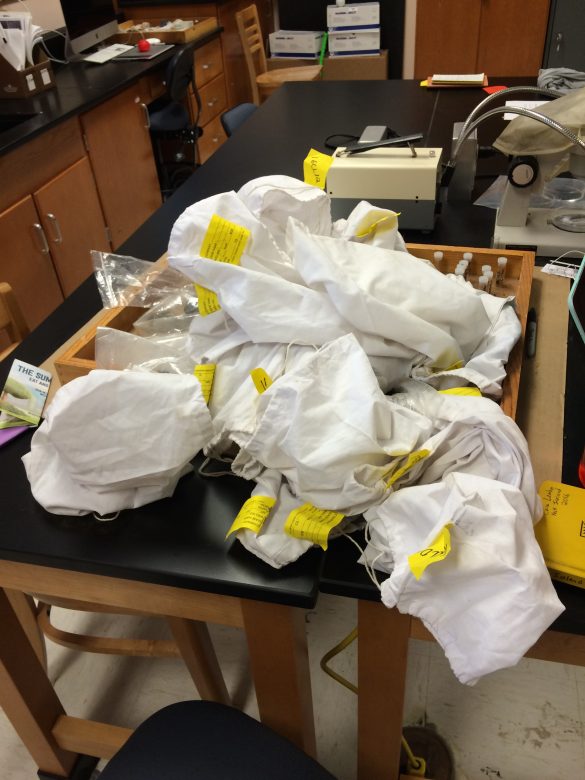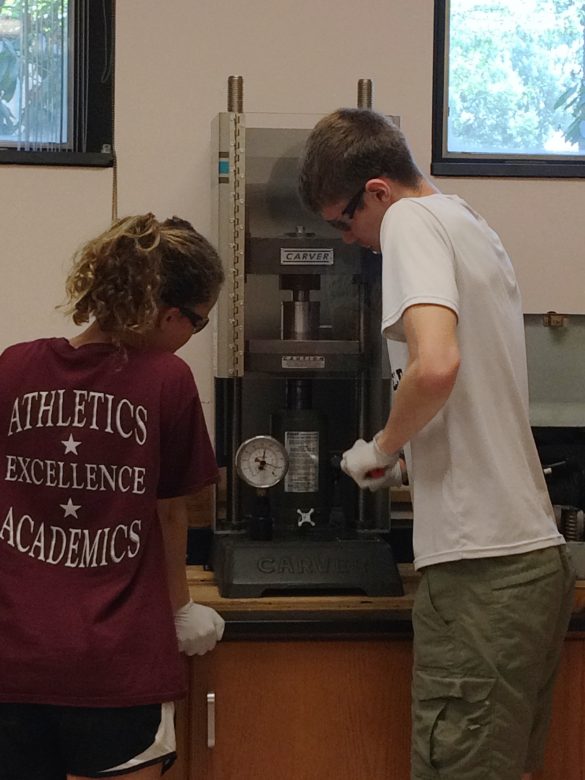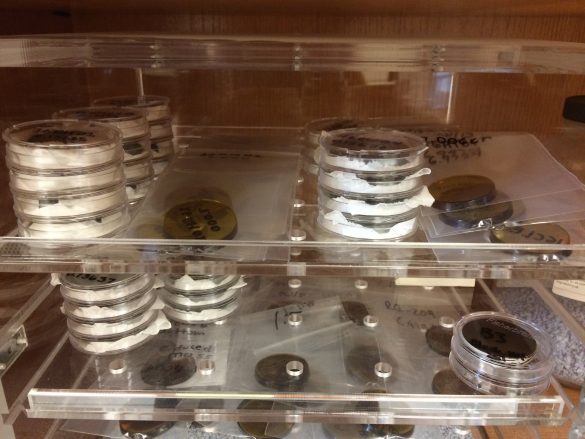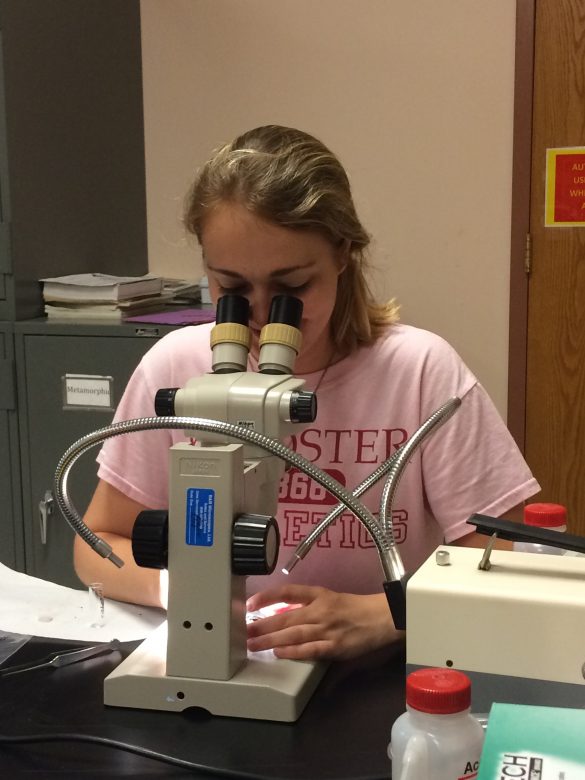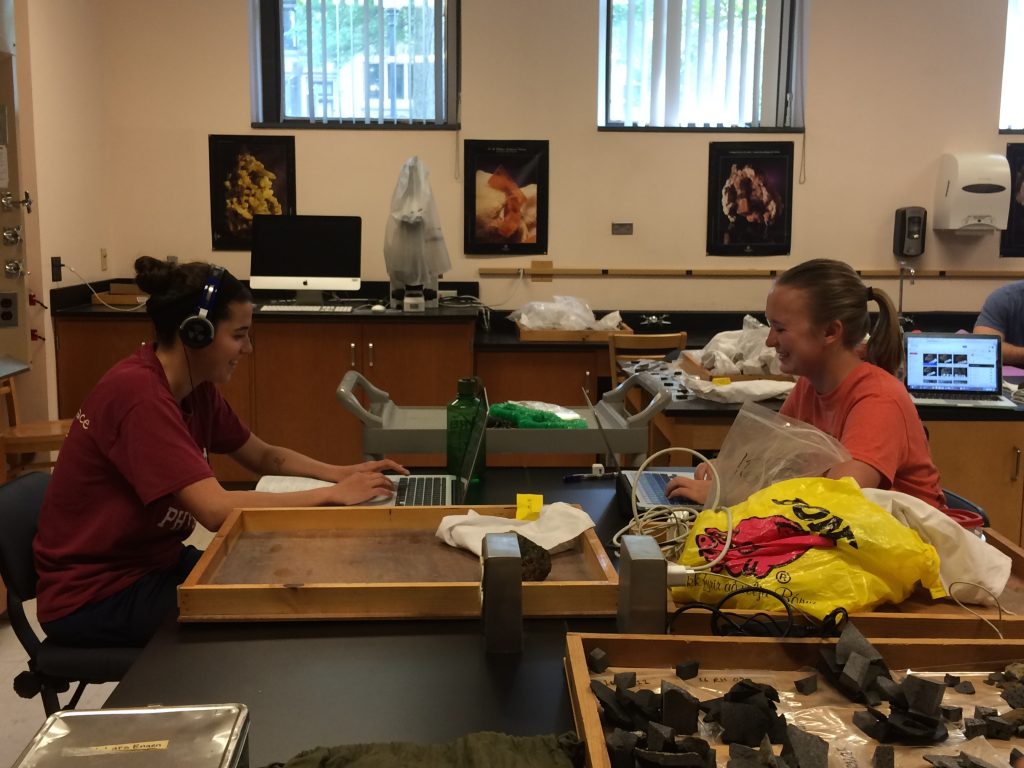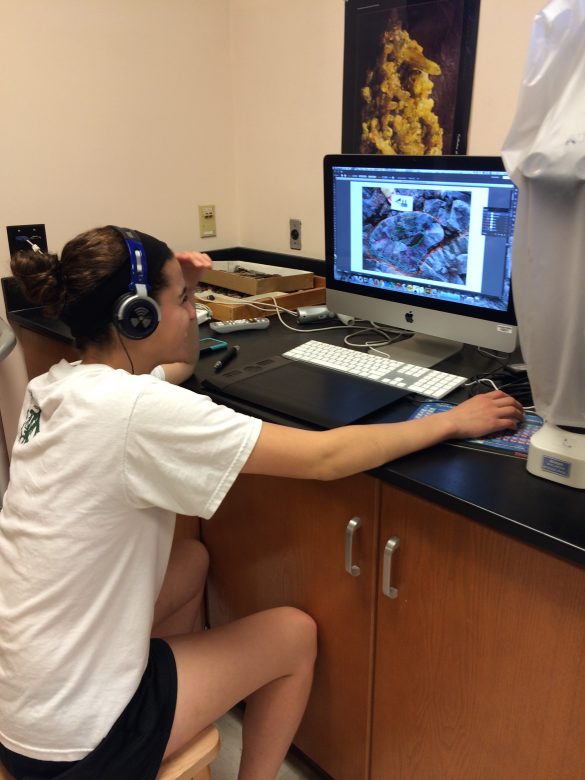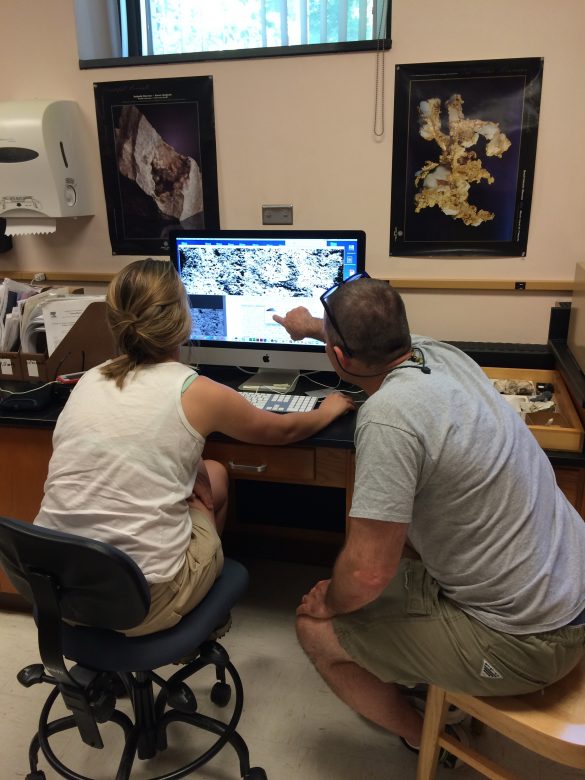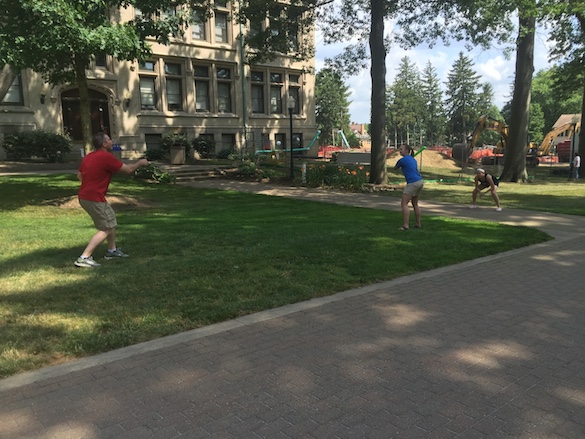Wooster, OH – The summer portion of the Keck Iceland project is officially over, but our research isn’t finished. We’ll be working together throughout the academic year and will synthesize our final results at the Keck Symposium at Wesleyan University in April 2017. Along the way, we’ll be presenting at GSA in Denver, Colorado. We wrote and submitted 4(!) abstracts based on our work this summer. Here they are:
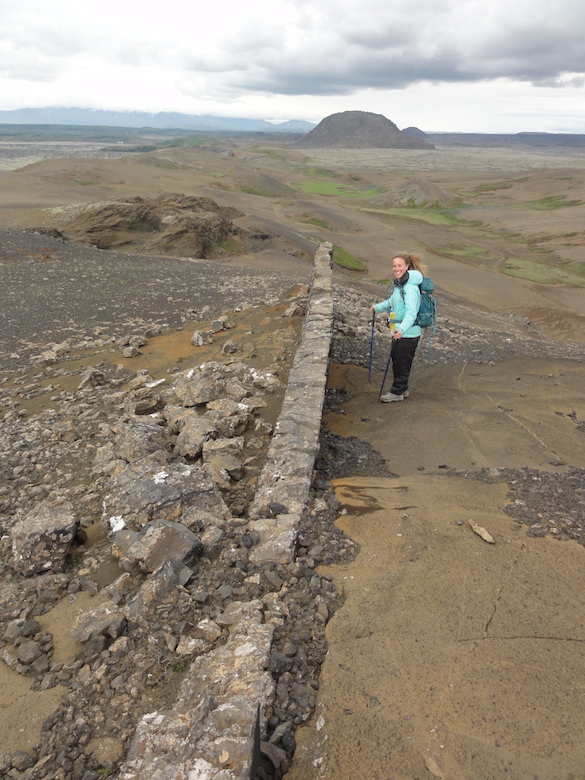
Cara Lembo (’17, Amherst) stands next to a ridge-parallel dike intruding through a tephra cone. Helgafell, a hyalocastite edifice, is in the distance.
NEW INSIGHTS ON THE FORMATION OF GLACIOVOLCANIC TINDAR RIDGES FROM DETAILED MAPPING OF UNDIRHLIDAR RIDGE, SW ICELAND
HEINEMAN, Rachel1, LEMBO, Cara2, ENGEN, Carl-Lars3, KOCHTITZKY, William4, WALLACE, Chloe5, ORDEN, Michelle4, THOMPSON, Anna C6, KUMPF, Benjamin5, EDWARDS, Benjamin R.4 and POLLOCK, Meagen5, (1)Department of Geology, Oberlin College, 52 West Lorain St, Oberlin, OH 44074, (2)Department of Geology, Amherst College, 11 Barrett Hill Dr, Amherst, MA 01002, (3)Department of Geology, Beloit College, 700 College Street, Box 777, Beloit, WI 53511, (4)Department of Earth Sciences, Dickinson College, 28 N. College Street, Carlisle, PA 17013, (5)Department of Geology, The College of Wooster, 944 College Mall, Wooster, OH 44691, (6)Department of Geology, Carleton College, One North College Street, Northfield, MN 55057, rheinema@oberlin.edu
Undirhlíðar ridge on the Reykjanes Peninsula in southwest Iceland is a glaciovolcanic tindar formed by fissure eruptions under ice. Previous work in two quarries along the ridge shows that this specific tindar has had a complex eruption history. Here we report new results from investigations along the length of the ridge (~3 km) between the quarries. We have identified aerially significant fragmental deposits and a potential vent area on the ridge’s eastern side. The newly mapped tephra deposits are dominated by lapilli- and ash-size grains that are palagonitized to some degree (~20-60%) but locally contain up to ~75% fresh glass. Basal units are tuff breccia to volcanic breccia with basaltic and rare gabbroic lithic clasts. Upper units are finely bedded with few large clasts and some glassy bombs. Locally, lapilli-tuff units show repetitive normally graded bedding and cross bedding. Measured bedding attitudes suggest that present exposures represent a moderately eroded tephra cone that was subsequently intruded by basaltic dikes. Extending north and south of the tephra cone, the upper surface of the ridge comprises pillow rubble with outcrops of massive basalts showing radial jointing and concentric vesicle patterns. All of the outcrops appear to be similar coarse-grained, olivine- and plagioclase-bearing basalts; ongoing petrographic and geochemical analysis will determine if the bodies represent “megapillows” or if they are related to intrusions that are present in both quarries. Along the western side of the ridge, lapilli tuff and/or volcaniclastic diamictites overlie pillow lava (or volcanic breccia made of pillow fragments) that is locally intruded by dikes. In northern gullies, at least two stratigraphically distinct units of pillow lava are present. In order to communicate the implications of our detailed research to a broad audience, we are constructing two “map tours” of the ridge: one that is centered on the abandoned and accessible Undirhlíðar quarry, and another that describes features along the upper part of the ridge between the quarries. Stops along the tour include exposures of dikes, pillow lavas, and erosional alcoves within the tephra cone. The goal of these tours is to compare similar units across the ridge and quarry and to show the general anatomy of a glaciovolcanic ridge.
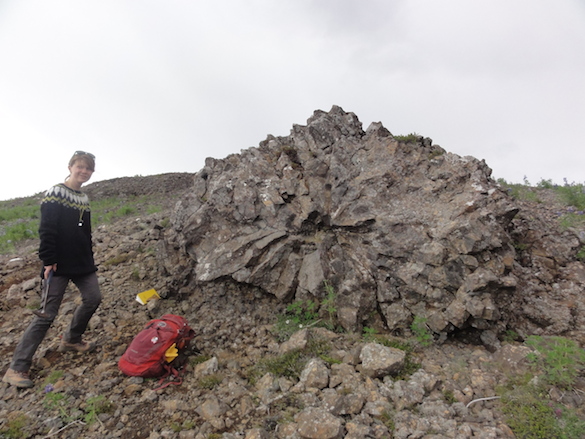
Rachel Heineman (’17, Oberlin) stands next to a potential “megapillow.”
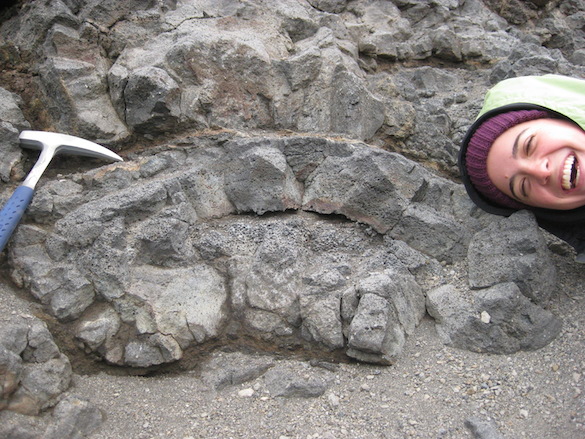
Cross section of a pillow lava, with Michelle Orden’s (’17, Dickinson) head for scale.
Pillow lavas are one of the most abundant lava morphologies on Earth, but are relatively inaccessible because of their submarine or subglacial eruption environments. Our research location in a former rock quarry in southwest Iceland provides a unique opportunity to view cross-sections through well exposed pillow lavas on land. The quarry is located at the northern end of Undirhlíðar, which is a glaciovolcanic ridge on the Krisuvik fissure system, and exposes thousands of individual pillow lavas. This study uses detailed field and laboratory observations of vesicle distributions and jointing patterns to better constrain the mechanisms that control vesiculation, bubble transport, and cooling rates during emplacement of pillow lava. From detailed analysis of >40 exposed pillow cross sections, we have identified 7 fracture characteristics that make up a combination of fracture patterns within the pillow lavas. These characteristics include: short (<5 cm) fractures at the outer edge of a pillow, fractures within pillow cores, fractures between the core and the edge of a pillow, long fractures (up to 40 cm) that go through the entire pillow, ‘web’-like fractures, fractures that branch from other fractures, and curvilinear fractures that cut through bands of vesicles. The distributions of vesicles are more diverse, with at least 12 different patterns defined by characteristics including: concentric banding, moderately/highly vesicular cores, non-vesicular cores, and open cavities. We identified 6 vesicle pattern combinations in the field, and are using image analysis of nearly 50 field photographs to characterize the patterns. These characteristics will constrain physical modeling to better understand how variations in emplacement conditions (abrupt pressure changes, lava discharge rates, water infiltration along fractures) are recorded by the lavas. These pillow lavas are the only lasting record of a preexisting englacial lake presumably formed during the eruption of the lavas, so understanding the details of their textures may provide new insights into the hydrology of the enclosing ice (occurrence of syn-eruption jokulhlaups, efficiency of sub-ice drainage).
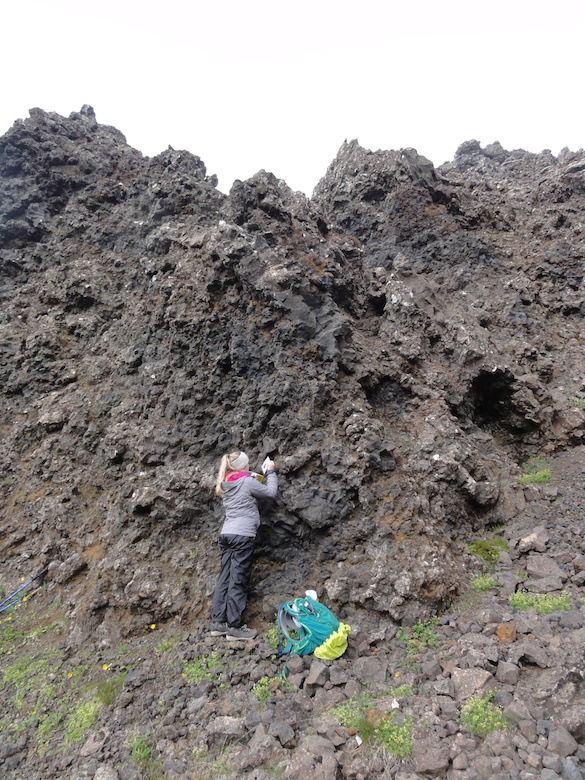
Chloe Wallace (’17, Wooster) samples glassy pillow lava rinds for geochemical analysis by XRF and FTIR.
GEOCHEMICAL CONSTRAINTS ON THE MAGMATIC SYSTEM AND ERUPTIVE ENVIRONMENT OF A GLACIOVOLCANIC TINDAR RIDGE FROM UNDIRHLíðAR, SW ICELAND
WALLACE, Chloe1, KUMPF, Benjamin1, HEINEMAN, Rachel2, LEMBO, Cara3, ORDEN, Michelle4, THOMPSON, Anna C5, ENGEN, Carl-Lars6, KOCHTITZKY, William4, POLLOCK, Meagen1, EDWARDS, Ben4and HIATT, Alex1, (1)Department of Geology, The College of Wooster, 944 College Mall, Wooster, OH 44691, (2)Department of Geology, Oberlin College, 52 West Lorain St, Oberlin, OH 44074, (3)Department of Geology, Amherst College, 11 Barrett Hill Drive, Amherst, MA 01002, (4)Department of Earth Sciences, Dickinson College, 28 N. College Street, Carlisle, PA 17013, (5)Department of Geology, Carleton College, One North College Street, Northfield, MN 55057, (6)Department of Geology, Beloit College, 700 College Street, Box 777, Beloit, WI 53511, cwallace17@wooster.edu
Glaciovolcanic tindar ridges are landforms created by the eruption of magma through fissure swarms into ice. The cores of many of these ridges comprise basaltic pillow lava, so they serve an accessible analogue for effusive mid-oceanic ridge volcanism. Furthermore, similar landforms have been identified on Mars, and thus they may also serve as models for planetary volcanic eruptions. To better understand pillow formation and effusive glaciovolcanic eruptions, we are investigating Undirhlíðar ridge, a pillow-dominated tindar on the Reykjanes Peninsula in southwest Iceland. Our detailed mapping and sampling in two rock quarries along the ridge and in the ~3 km area between the quarries show that this specific tindar ridge has had a complex eruption history. In the northern quarry (Undirhlíðar), Pollock et al. (2014) demonstrated that at least two geochemically distinct magma batches have erupted. Further trace element and isotope analyses in the southern quarry (Vatnsskarð) suggest that the ridge is fed by a heterogeneous mantle source. Isotopic Pb data show a spatially systematic linear array, which is consistent with a heterogeneous mantle mixing between depleted and enriched endmembers. The occurrence of multiple magma batches in dikes and irregular intrusions suggests that these structures are important to transporting magma within the volcanic edifice. Glassy pillow rinds were sampled for volatile analysis by FTIR in order to determine how paleo-water pressures vary along the ridge. In Undirhlíðar quarry, paleo-water pressures decrease with stratigraphic height (1.6-0.7 MPa). In Vatnsskarð quarry, paleo-water pressures show evidence of two separate eruptions, where pressure values decrease with an increase in stratigraphic height from 1.1 to 0.7 MPa over ~30 m, at which point pressure resets to 1.1 MPa and continues to decrease with elevation. When comparing the two quarries, paleo-water pressures in the upper units of Undirhlíðar and all the units in Vatnsskarð have similar values (0.7-1.1 MPa), and these are lower than the basal units of Undirhlíðar (1.2-1.6 MPa). Overall, compositional variations correlate with stratigraphy and spatial distribution along axis, suggesting that glaciovolcanic eruptions and their resulting landforms show a higher level of complexity than previously thought.
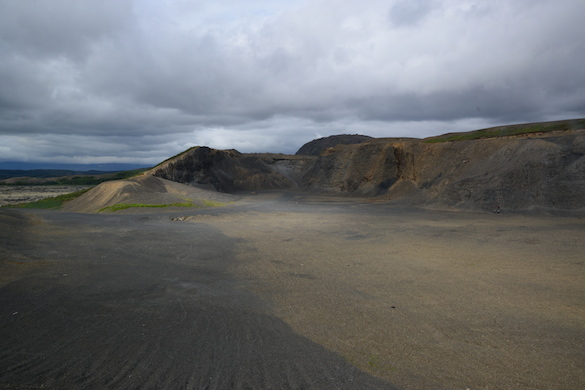
A view looking NE into Undirhlidar quarry on a moody Icelandic day. (Photo Credit: Ben Edwards)
 Rochester, Minnesota — It was a good day for fossil collecting on the Minnesota prairie. Above you see a handful of articulated orthid brachiopods collected by Nikki Bell at a quarry exposure near Rochester.
Rochester, Minnesota — It was a good day for fossil collecting on the Minnesota prairie. Above you see a handful of articulated orthid brachiopods collected by Nikki Bell at a quarry exposure near Rochester. This quarry has long been abandoned and is quickly reverting back to woodlands except for the steepest parts of the old walls. The grey streak visible through the trees is our site where the Decorah Shale is exposed.
This quarry has long been abandoned and is quickly reverting back to woodlands except for the steepest parts of the old walls. The grey streak visible through the trees is our site where the Decorah Shale is exposed. As usual, we worked on steep slopes with plenty of foliage. The fossils, though, were easy to find.
As usual, we worked on steep slopes with plenty of foliage. The fossils, though, were easy to find. The shale has thin limestone beds penetrated thoroughly by the trace fossils Chondrites (the small holes visible in the slab above). This particular rock shows hummocky cross-stratification on its top surface (the dips and ridges), almost certainly an indication it was deposited during an Ordovician storm.
The shale has thin limestone beds penetrated thoroughly by the trace fossils Chondrites (the small holes visible in the slab above). This particular rock shows hummocky cross-stratification on its top surface (the dips and ridges), almost certainly an indication it was deposited during an Ordovician storm. Rachel Wetzel (Pennsylvania) is working with the fossils from this quarry and our other Decorah outcrops to put together a general paleoecological reconstruction and then explore in detail the bryozoans. She is particularly adept at effortlessly clinging to steep slopes!
Rachel Wetzel (Pennsylvania) is working with the fossils from this quarry and our other Decorah outcrops to put together a general paleoecological reconstruction and then explore in detail the bryozoans. She is particularly adept at effortlessly clinging to steep slopes! Nikki Bell (California) is working on the Decorah fossils with Rachel. Her specialty will be the brachiopods.
Nikki Bell (California) is working on the Decorah fossils with Rachel. Her specialty will be the brachiopods. Etienne Fang (Maryland) is studying the “iron ooids” found in the Decorah Shale at this quarry and several other sites.
Etienne Fang (Maryland) is studying the “iron ooids” found in the Decorah Shale at this quarry and several other sites. Dean Thomas (Virginia) will be assessing the carbonate petrology and conodonts of the Decorah Shale, along with the underlying Platteville and overlying Cummingsville Formations. His main outcrop will be in Iowa, but he’s also collecting limestone specimens within the Decorah at other locations for biostratigraphic correlation. All four student projects are integrated, with the whole team collecting data and samples for each individual project.
Dean Thomas (Virginia) will be assessing the carbonate petrology and conodonts of the Decorah Shale, along with the underlying Platteville and overlying Cummingsville Formations. His main outcrop will be in Iowa, but he’s also collecting limestone specimens within the Decorah at other locations for biostratigraphic correlation. All four student projects are integrated, with the whole team collecting data and samples for each individual project. Our superb geological technician Nick Wiesenberg has also been collecting fossils for us.
Our superb geological technician Nick Wiesenberg has also been collecting fossils for us. A typical lunch in the woods for us. We’ve had surprisingly few mosquitoes, and very patchy interactions with parasites. Dean is a tick magnet, and I’ve been badly chiggered!
A typical lunch in the woods for us. We’ve had surprisingly few mosquitoes, and very patchy interactions with parasites. Dean is a tick magnet, and I’ve been badly chiggered! Our last stop of the day was the annoying Golden Hill roadcut (N 43.98788°, W 92.47962°). It is next to an off-ramp of US 52/63 so we have to reach it by descending through a bouldery, overgrown culvert from above. The students did their jobs, though, and did good sampling.
Our last stop of the day was the annoying Golden Hill roadcut (N 43.98788°, W 92.47962°). It is next to an off-ramp of US 52/63 so we have to reach it by descending through a bouldery, overgrown culvert from above. The students did their jobs, though, and did good sampling. This spindly green bush is wild parsnip (Pastinaca sativa), a plant we’re careful to avoid despite its abundance in some very inconvenient places. It is often referred to as poison parsnip for good reasons. These plants contain “furocoumarins, chemicals that when combined with skin and ultraviolet light can cause what’s known as a phytophotodermatitis”. You have to contact the sap of the plant and then be exposed to the sun, so brushing against it is not a problem. We worry about grabbing a stalk and breaking it in our hands while clinging to slippery slopes.
This spindly green bush is wild parsnip (Pastinaca sativa), a plant we’re careful to avoid despite its abundance in some very inconvenient places. It is often referred to as poison parsnip for good reasons. These plants contain “furocoumarins, chemicals that when combined with skin and ultraviolet light can cause what’s known as a phytophotodermatitis”. You have to contact the sap of the plant and then be exposed to the sun, so brushing against it is not a problem. We worry about grabbing a stalk and breaking it in our hands while clinging to slippery slopes. Here’s a closer view of the wild parsnip. We also deal with poison ivy, stinging nettles, thistles and other sticker bushes. Sometimes I miss my desert fieldwork!
Here’s a closer view of the wild parsnip. We also deal with poison ivy, stinging nettles, thistles and other sticker bushes. Sometimes I miss my desert fieldwork! Of course, most plants here are benign and often beautiful. These yellow flowers were abundant today at our first quarry. I suspect this is Lotus corniculatus (Birds-foot Trefoil). Unfortunately the description of this flower says, “This is a terrible pest plant …”
Of course, most plants here are benign and often beautiful. These yellow flowers were abundant today at our first quarry. I suspect this is Lotus corniculatus (Birds-foot Trefoil). Unfortunately the description of this flower says, “This is a terrible pest plant …”







